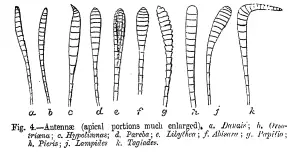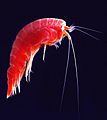Difference between revisions of "Antenna (biology)" - New World Encyclopedia
Rick Swarts (talk | contribs) (added most recent wikipedia article) |
Rick Swarts (talk | contribs) |
||
| Line 1: | Line 1: | ||
{{Contracted}} | {{Contracted}} | ||
[[Image:Insect antennae.jpg|thumb|right|100px|[[Insect]]s display a wide variety of antennal shapes.]] | [[Image:Insect antennae.jpg|thumb|right|100px|[[Insect]]s display a wide variety of antennal shapes.]] | ||
| − | '''Antennae''' (singular '''antenna''') are paired | + | '''Antennae''' (singular '''antenna''') are paired appendages connected to the front-most segments of [[arthropod]]s. In [[crustacean]]s, they are [[biramous]] and present on the first two segments of the head, with the smaller pair known as '''antennules'''. All other arthropod groups, except [[Chelicerata|chelicerates]] and [[protura]]ns which have none, have a single, [[uniramous]] pair of antennae. |
| + | |||
| + | Arthropods are [[invertebrate]]s that are characterized by the possession of a segmented body, a pair of jointed appendages on each segment, and an [[exoskeleton]]. The jointed appendages, which include both legs and antennae, are the source for the name arthropod, which comes from the [[Greek language|Greek]] word for ''jointed foot.'' | ||
Antennae are jointed, at least at the base, and generally extend forward from the head. They are [[Sensory system|sensory organ]]s, although the exact nature of what they sense and how they sense it is not the same in all groups, nor always clear. Functions may variously include sensing [[touch]], air motion, heat, vibration (sound), and especially [[olfaction]] (smell) or [[gustation]] (taste). | Antennae are jointed, at least at the base, and generally extend forward from the head. They are [[Sensory system|sensory organ]]s, although the exact nature of what they sense and how they sense it is not the same in all groups, nor always clear. Functions may variously include sensing [[touch]], air motion, heat, vibration (sound), and especially [[olfaction]] (smell) or [[gustation]] (taste). | ||
| + | |||
| + | |||
| + | Many [[crustacean]]s and [[insect]]s can regenerate legs and antennas, as well as claws. | ||
==Insects== | ==Insects== | ||
[[Image:Insect antennae.svg|240px|thumb|left|Terms used to describe antennae shapes]] | [[Image:Insect antennae.svg|240px|thumb|left|Terms used to describe antennae shapes]] | ||
[[Image:antennae_ctb.png|thumb|bob saget240px|left|Antennal shape in the [[Lepidoptera]] from C. T. Bingham (1905)]] | [[Image:antennae_ctb.png|thumb|bob saget240px|left|Antennal shape in the [[Lepidoptera]] from C. T. Bingham (1905)]] | ||
| + | |||
| + | Insects are distinguished from other arthropods by having ''three pairs'' of jointed legs; an abdomen that is divided into 11 segments and lacks any legs or wings; and a body separated into three parts (head, thorax, and abdomen), with one pair of [[antennae]] on the head. | ||
In [[insect]]s, [[olfactory receptor]]s on the antennae bind to [[odor|odour]] molecules, including [[pheromone]]s. The [[neuron]]s that possess these receptors signal this binding by sending [[action potential]]s down their [[axon]]s to the [[antennal lobe]] in the [[brain]]. From there, neurons in the antennal lobes connect to [[mushroom bodies]] that identify the odour. The sum of the electrical potentials of the antenna to a given odor can be measured using an [[electroantenogram]]. | In [[insect]]s, [[olfactory receptor]]s on the antennae bind to [[odor|odour]] molecules, including [[pheromone]]s. The [[neuron]]s that possess these receptors signal this binding by sending [[action potential]]s down their [[axon]]s to the [[antennal lobe]] in the [[brain]]. From there, neurons in the antennal lobes connect to [[mushroom bodies]] that identify the odour. The sum of the electrical potentials of the antenna to a given odor can be measured using an [[electroantenogram]]. | ||
| Line 13: | Line 20: | ||
==Crustaceans== | ==Crustaceans== | ||
| + | '''Crustaceans''' (subphylum '''Crustacea''') are the group of [[arthropod]]s (phylum Arthropoda) that includes the familiar [[crab]]s, [[lobster]]s, [[shrimp]]s, [[barnacle]]s, copepods, krill, water fleas, and crayfish. | ||
| + | Crustaceans are characterized by having branched (biramous) appendages, an exoskeleton made up of chitin and calcium, two pairs of antennae that extend in front of the mouth, and paired appendages that act like jaws, with three pairs of biting mouthparts. | ||
| + | |||
[[Crustacean]]s bear two pairs of antennae. The first pair are [[uniramous]] and are often referred to an ''antennules'', while the second pair are [[biramous]], meaning that each antenna is composed of two parts, joined at their base <ref>{{cite web |url=http://www.geo.arizona.edu/geo3xx/geo308_fall2002/6arthropods.htm |title=Superphylum Arthropoda |publisher=[[University of Arizona]]}}</ref>. In most adults, the antenna are sensory organs, but they are used by the [[nauplius (larva)|nauplius]] [[larva]] for both feeding and swimming. In some groups of crustaceans, such as the [[spiny lobster]]s and [[slipper lobster]]s, the second antennae are enlarged, while in others, such as [[crab]]s, the antennae are reduced in size. | [[Crustacean]]s bear two pairs of antennae. The first pair are [[uniramous]] and are often referred to an ''antennules'', while the second pair are [[biramous]], meaning that each antenna is composed of two parts, joined at their base <ref>{{cite web |url=http://www.geo.arizona.edu/geo3xx/geo308_fall2002/6arthropods.htm |title=Superphylum Arthropoda |publisher=[[University of Arizona]]}}</ref>. In most adults, the antenna are sensory organs, but they are used by the [[nauplius (larva)|nauplius]] [[larva]] for both feeding and swimming. In some groups of crustaceans, such as the [[spiny lobster]]s and [[slipper lobster]]s, the second antennae are enlarged, while in others, such as [[crab]]s, the antennae are reduced in size. | ||
Revision as of 02:52, 17 March 2007

Antennae (singular antenna) are paired appendages connected to the front-most segments of arthropods. In crustaceans, they are biramous and present on the first two segments of the head, with the smaller pair known as antennules. All other arthropod groups, except chelicerates and proturans which have none, have a single, uniramous pair of antennae.
Arthropods are invertebrates that are characterized by the possession of a segmented body, a pair of jointed appendages on each segment, and an exoskeleton. The jointed appendages, which include both legs and antennae, are the source for the name arthropod, which comes from the Greek word for jointed foot.
Antennae are jointed, at least at the base, and generally extend forward from the head. They are sensory organs, although the exact nature of what they sense and how they sense it is not the same in all groups, nor always clear. Functions may variously include sensing touch, air motion, heat, vibration (sound), and especially olfaction (smell) or gustation (taste).
Many crustaceans and insects can regenerate legs and antennas, as well as claws.
Insects

Insects are distinguished from other arthropods by having three pairs of jointed legs; an abdomen that is divided into 11 segments and lacks any legs or wings; and a body separated into three parts (head, thorax, and abdomen), with one pair of antennae on the head. In insects, olfactory receptors on the antennae bind to odour molecules, including pheromones. The neurons that possess these receptors signal this binding by sending action potentials down their axons to the antennal lobe in the brain. From there, neurons in the antennal lobes connect to mushroom bodies that identify the odour. The sum of the electrical potentials of the antenna to a given odor can be measured using an electroantenogram.
The three basic segments of the typical insect antenna are the scape (base), the pedicel (stem), and finally the flagellum, which often comprises many units known as flagellomeres (the number of flagellomeres can vary greatly, and is often of diagnostic importance). True flagellomeres have a membranous articulation between them, but in many insects, especially the more primitive groups, the flagellum is entirely or partially composed of a flexible series of small annuli, which are not true flagellomeres. In many beetles and in the chalcidoid wasps, the apical flagellomeres form a club, and the collective term for the segments between the club and the antennal base is the funicle (or funiculus); for traditional reasons, in beetles it is the segments between the club and the scape, but in wasps, it is the segments between the club and the pedicel. In the groups with more uniform antennae (for example: Diplopoda), all segments are called antennomeres. Some groups have a simple or variously modified apical or subapical bristle called an arista (this may be especially well-developed in various Diptera).
Crustaceans
Crustaceans (subphylum Crustacea) are the group of arthropods (phylum Arthropoda) that includes the familiar crabs, lobsters, shrimps, barnacles, copepods, krill, water fleas, and crayfish. Crustaceans are characterized by having branched (biramous) appendages, an exoskeleton made up of chitin and calcium, two pairs of antennae that extend in front of the mouth, and paired appendages that act like jaws, with three pairs of biting mouthparts.
Crustaceans bear two pairs of antennae. The first pair are uniramous and are often referred to an antennules, while the second pair are biramous, meaning that each antenna is composed of two parts, joined at their base [1]. In most adults, the antenna are sensory organs, but they are used by the nauplius larva for both feeding and swimming. In some groups of crustaceans, such as the spiny lobsters and slipper lobsters, the second antennae are enlarged, while in others, such as crabs, the antennae are reduced in size.
ReferencesISBN links support NWE through referral fees
- ↑ Superphylum Arthropoda. University of Arizona.
External link
Credits
New World Encyclopedia writers and editors rewrote and completed the Wikipedia article in accordance with New World Encyclopedia standards. This article abides by terms of the Creative Commons CC-by-sa 3.0 License (CC-by-sa), which may be used and disseminated with proper attribution. Credit is due under the terms of this license that can reference both the New World Encyclopedia contributors and the selfless volunteer contributors of the Wikimedia Foundation. To cite this article click here for a list of acceptable citing formats.The history of earlier contributions by wikipedians is accessible to researchers here:
The history of this article since it was imported to New World Encyclopedia:
Note: Some restrictions may apply to use of individual images which are separately licensed.



